|
 Russula vinaceocuticulata Russula vinaceocuticulata
BiostatusPresent in region - Indigenous. Endemic
Images (click to enlarge)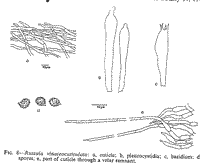 | 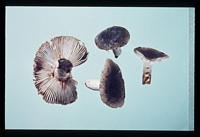
Owner: Herb. PDD | 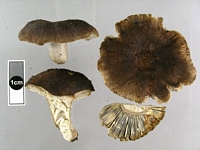
Owner: J.A. Cooper | 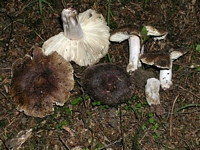
Owner: J.A. Cooper | 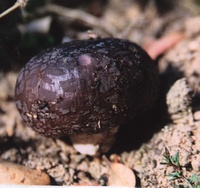
Owner: P. Leonard | 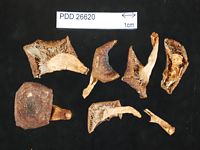
Caption: Dried type specimen
Owner: Herb PDD |
Article: McNabb, R.F.R. (1973). Russulaceae of New Zealand. 2. Russula Pers. ex S.F. Gray. New Zealand Journal of Botany 11(4): 673-730 (http://www.rsnz.org/publish/abstracts.php).
Description: pileus: 3.5-9 cm diam., hemispherical when young, centrally depressed at maturity, viscid, early creviced with areolate patches crowded in centre and becoming less numerous and scattered towards margins, ground colour dark brownish black, dark brown, or dark greyish brown in centre, paling to brownish grey towards margins with ridges typically darker than intervening grooves, areolae greyish ruby, greyish magenta, or vinaceous; margins thin, entire, distinctly or faintly pectinate for up to 1.5 cm from edge. Cuticle consisting of distinct epicutis and subcutis: epicutis composed of erect or tangled, smooth, septate, thin-walled, hair like hyphae to 200 µm long, 2.5-5 µm diam., without coloured contents but walls reddish brown in KOH, arising from relatively short-celled, slightly inflated hyphae; subcutis heavily gelatinised, composed of interwoven, thin-walled, septate hyphae 1.5-4.5 µm diam., repent or obliquely ascending, oleiferous hyphae occasionally present. lamellae: adnexed to adnate, crowded, moderately thin, simple or forked near stipe, to 8 mm deep, sordid white to pallid creamy white with greyish tints, discoloured with numerous dull reddish brown or rusty spots and stains at maturity, lamellulae rare to numerous. stipe: 1.5-4 cm long, ± equal, 0.8-2 cm diam., solid or chambered, occasionally hollowed at maturity, dry, subglabrous to finely felted under lens, white, sordid white, or pallid creamy white, often with greyish tints, greyish ruby to vinaceous at extreme base; flesh white to sordid white, unchanging-on exposure to air. Cuticle composed of interwoven hyphae 4-7.5 µm diam., terminal cells tapering apically, projecting, aggregated into clumps and incorporating caulocystidia-like elements with capitulate apices. spores: spore print cream to creamy yellow; spores broadly elliptical, obliquely apiculate, apiculus to 1.5-(2) µm long, 7.5-10 X 6.5-8.5 µm, ornamentation of moderately dense, amyloid verrucae to 0.7 µm high, isolated, in small confluent groups, or joined by moderately fine amyloid ridges and forming an incomplete reticulum; plage absent. hymenium: basidia hyaline, clavate, 39-48 X 7.5-10 µm, 4-spored, sterigmata to 7 µm long; pleurocystidia scattered, sparse, fusiform to subclavate or clavate, hyaline, thin-walled, contents sparse, projecting to 20 µm beyond basidia, apices strangulate or capitulate, 52-75 X 7.5-10 µm; cheilocystidia sparse, similar to pleurocystidia but shorter. hymenophoral trama: heteromerous, intermixed. context of pileus: Sordid white to pallid brownish white, unchanging; structure heteromerous, clamp connections absent. taste: lamellae and context mild. chemical characters: formalin on context —n.r.; phenol on context—slowly deep vinaceous; FeSO4 on context— rapidly salmon pink; guaiacol on stipe base—rapidly pinkish orange, darkening with time; KOH on pileus—darkening; on context—n.r.; NH4OH on pileus and context—n.r.
Habitat: solitary or gregarious under Leptospermum and Nothofagus.
Notes: The epicutis appears to be velar remnants but the long hairs are parts of the cuticle which early crevices into areolate patches.
|